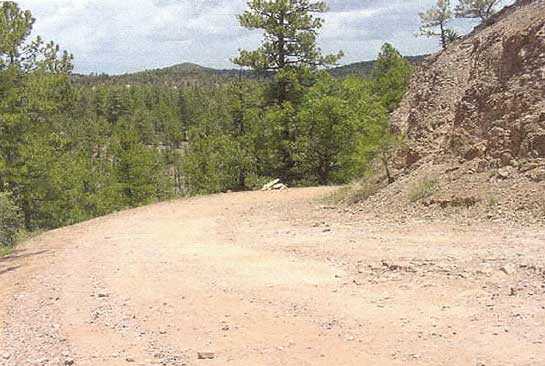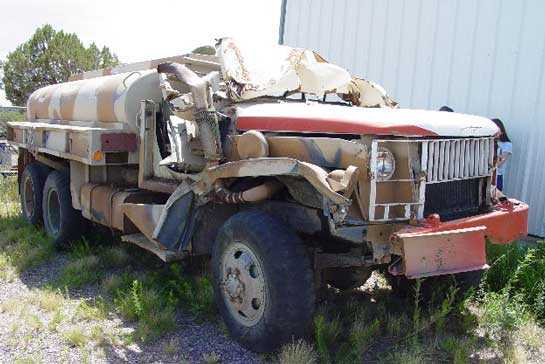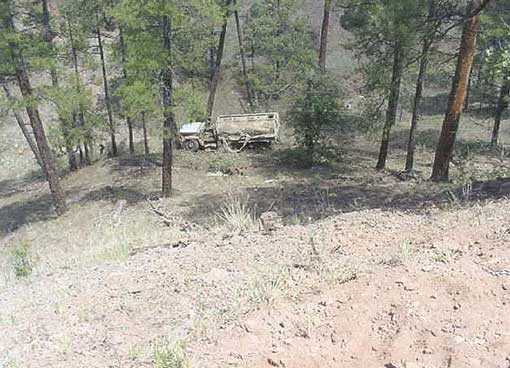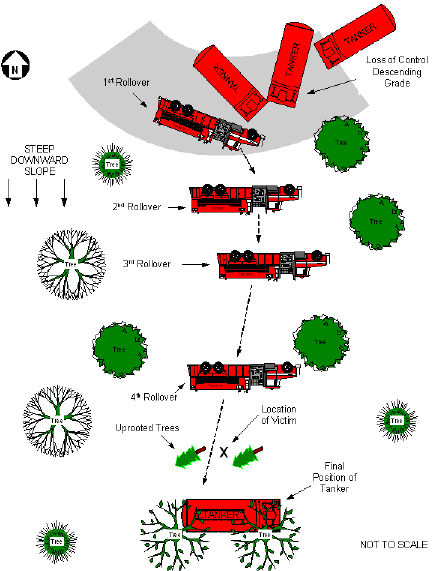Volunteer Assistant Chief Dies in Tanker Rollover - New Mexico
 Death in the Line of Duty...A summary of a NIOSH fire fighter fatality investigation
Death in the Line of Duty...A summary of a NIOSH fire fighter fatality investigation
F2003-23 Date Released: November 4, 2003
SUMMARY
On June 26, 2003, a 46-year old male volunteer Assistant Chief (the victim) was fatally injured after being ejected from a water tanker as a result of a rollover crash. The victim was traveling to a wildland fire on an unpaved road within a National Forest. The tanker failed to negotiate a curve, rolled over, left the road, and rolled several more times down into a canyon. The victim was ejected from the cab during the rollover and was found lying unresponsive on the ground. He was pronounced dead at the scene.
NIOSH investigators concluded that, to minimize the risk of similar occurrences, fire departments should
determine a safe operating weight for water tankers based on vehicle characteristics and remove overweight vehicles from service
develop comprehensive apparatus maintenance programs and guidelines that include regularly scheduled inspections, documentation, and procedures for removing apparatus from service until major defects are repaired
ensure that all fire apparatus are equipped with seat belts
Additionally, States should
consider developing a vehicle inspection and maintenance program prior to distributing surplus military vehicles to the fire service
INTRODUCTION
On June 26, 2003, a 46-year-old male volunteer Assistant Chief (the victim) was fatally injured after being ejected from a water tanker as a result of a rollover crash. On June 30, 2003, the U.S. Fire Administration (USFA) notified the National Institute for Occupational Safety and Health (NIOSH) of this fatality. On July 10, 2003, a telephone interview was conducted with a volunteer Captain who was traveling behind the tanker (in another vehicle) at the time of the incident. On July 29–30, 2003, two safety and occupational health specialists from the NIOSH Fire Fighter Fatality Investigation and Prevention Program investigated the incident. The NIOSH team met with the Chief of the volunteer department involved in the incident, visited the site of the crash accompanied by representatives of the State Forest Service, and interviewed a National Forest Service law enforcement officer who was the first police officer on the scene. The Forest Service representatives pointed out the approximate locations of the tanker and the victim at the time of the incident. The apparatus involved in the incident was inspected. The State police accident report, National Forest Service law enforcement investigation report, and the medical investigator’s report were also reviewed.
The volunteer fire department involved in this incident has 14 fire fighters that operate from a single station. The department serves a rural ranching and farming community with a population of 500 in an area of approximately 500 square miles. The department receives the majority of its funding through the State. The victim had been with the department for 8 years and was serving as Assistant Chief. The victim also served as Chief in a neighboring volunteer fire department for the past 20 years.
Training
The State of New Mexico requires that volunteer fire fighters be NFPA Fire Fighter I certified within two years of joining a department. The State also requires that emergency vehicle operators hold a Class E driver’s license, which the victim held, and that the license be renewed every 4 years. A Class E license is an exemption license that waives fire fighters from the requirements of a Commercial Drivers License and authorizes emergency personnel to operate emergency vehicles in excess of 26,001 pounds. The volunteer department requires that new fire fighters be trained on each specific apparatus by experienced department personnel.
The victim had responded to previous calls in the incident apparatus within the last six months and was familiar with its operation. He was certified as NFPA Fire Fighter I, Wildland Type I Area Commander, apparatus/engine operator, and he was an emergency medical technician. He was also the New Mexico Search and Rescue Area Coordinator, responsible for all searches within the State.
Road and Weather Conditions
This incident occurred on a 45-degree curve on an unpaved mountainous road, with an approximate 8 to 10 degrees downgrade, within a National Forest (see Photo 1). The road had a steep drop-off to a canyon, approximately 150 feet below. The road was approximately 27 feet wide and did not have a shoulder, guardrails or a posted speed limit. The State police report estimated 15 mph as the safest speed on this road. The road surface was gravel and dry at the time of the incident. According to the State police accident report, there were no adverse weather conditions on the day of the incident. The tanker was still several miles from the fire at the time of the incident and no smoke was present. The weather was sunny, with temperatures about 90oF.
Equipment
The apparatus involved in this incident was a surplus 1954 2½-ton military fuel servicing truck with a multi-fuel engine (see Photo 2). The truck had a rectangular 1,200-gallon tank with one central side-to-side internal baffle. The tank was originally used to transport diesel fuel. In the rear, the truck was equipped with a small gasoline-powered pump and piping for water transfer. The overall vehicle length was 22 feet, vehicle width was 6.7 feet, and the wheelbase was 15 feet. The vehicle’s empty weight was 14,970 lbs; the vehicle weight with a full tank of water was 24,930 lbs.
This vehicle had a 5-speed manual transmission with a 2-range transfer case. These trucks can carry 2½-tons of cargo off-road (hence their common nickname, “deuce and a half”). It had 6-wheel drive with dual wheels on the rear axles. There are a total of 10 wheels on the ground, all of them driven, giving the truck maximum traction for off-road use. This vehicle would have a top speed of about 50 mph on the highway. The vehicle had a drum, air over hydraulic braking system. The vehicle did not have seat belts.
The tanker was owned by the U.S. Department of Agriculture, Forest Service and was acquired by the department through the New Mexico Forestry Division, Federal Excess Property Program (FEPP).1 Surplus apparatus obtained through the FEPP must only be used for fire fighting and the fire department is responsible for all maintenance, upkeep, and insurance. The apparatus had been transferred to the victim’s volunteer fire station about 5-6 years ago. The tanker made approximately 2-3 calls per year and was primarily used by the department for grass fires.
INVESTIGATION
The tanker involved in this incident was assigned to shuttle water to brush trucks on the scene of a wildland fire in a National Forest. The tanker was en route to the scene when the rollover occurred. On June 25, 2003, the District Forester with the New Mexico Forestry Division had called the victim’s volunteer department and requested their tanker on scene as a backup resource. On the morning of June 26, 2003, the victim had called a Captain from a neighboring volunteer fire department and requested his assistance in transporting the tanker to the wildland fire scene approximately 150 miles away. The two were planning on spending seven days shuttling water to brush trucks on the fire line.
They met at the fire station at approximately 1130 hours and began a safety check of the tanker. The Captain found two tires with low air that he re-inflated. The victim checked the engine and all vehicle fluids including the brake fluid (Note: The brake master cylinder for this truck is accessed though the floor within the cab and the victim topped off the fluid). Although both fire fighters had planned on riding in the tanker; they had too much equipment so they took a second vehicle, a fire department sports utility vehicle (SUV). The victim had packed both his wildland and structural bunker gear (including SCBA), and supplies for a seven day stay at the wildland fire. The Captain packed his wildland gear bag and luggage. They left the fire station at approximately 1300-1400 hours. The victim was driving the tanker and the Captain followed in the SUV.
They drove approximately 135 miles on State and interstate highways prior to reaching the National Forest. At approximately 1945 hours, on a mountainous road within the National Forest, around a downward sloping curve, the victim’s truck rolled over and left the road (see Photo 3). According to the State police accident report, the tanker rolled over 4 times prior to coming to rest 123 feet down the canyon. The victim was ejected from the cab landing in front of the tanker on the second rollover. The State police reported that the tanker had rolled over the victim prior to coming to a stop. His body was found in the canyon approximately 100 feet from the road.
The Captain did not witness the incident, but saw a “big cloud of dust through the trees” as he rounded the curve. He knew immediately what had happened and radioed for assistance. A wildland spotter plane responded and notified the National Forest central dispatch. The Captain administered first aid to the victim, but he did not have a pulse.
An area volunteer fire department heard the radio traffic and dispatched a rescue unit that arrived on scene within 15 minutes. A National Forest Service law enforcement officer arrived on scene a few minutes after the rescue unit. After the rollover, the National Forest Service officer reported that the tanker’s engine was still running; when she climbed into the cab to shut off the engine, she found the transmission in neutral and complete brake failure. (Note: The brake pedal could be depressed completely to the floor with no resistance). She hypothesizes that the victim lost his brakes as he approached the curve; he tried to downshift the transmission but missed the gear. The loss of control resulted in a counter clockwise skid and simultaneous rollover (see Diagram). The tanker left the road and rolled three more times down the canyon, finally coming to rest upright against two trees. (Note: The water tank was found half full after the incident; the Captain reported that the tank was full prior to departure).
The State police arrived at 2026 hours and the victim was pronounced dead on the scene at 2255 hours by a State Medical Investigator.
CAUSE OF DEATH
According to the medical investigator’s report, the cause of death was multiple injuries consistent with a rollover motor vehicle crash.
RECOMMENDATIONS/DISCUSSIONS
Recommendation #1: Fire departments should determine a safe operating weight for water tankers based on vehicle characteristics and remove overweight vehicles from service.2
Discussion: The U.S. Fire Administration has reported that very serious overweight situations and accidents have occurred with tankers that were once surplus military 2½-ton vehicles. These vehicles are usually worn out and no longer suitable for military service when received by fire departments.2 The weight of these vehicles’s payload without personnel should not exceed 5,000 pounds (2½-tons) when traveling off-road and 7,500 lbs (3¾-tons) when traveling on the highway. Since water weighs 8.3 pounds per gallon, 5,000 lbs of water is about 600 gallons. The vehicle involved in this incident had a 1,200 gallon tank and the water weight alone from a full tank would be 9,960 lbs, thus exceeding the vehicle’s payload capacity when traveling either on the highway or off-road.
Recommendation #2: Fire departments should develop comprehensive apparatus maintenance programs and guidelines that include regularly scheduled inspections, documentation, and procedures for removing apparatus from service until major defects are repaired.3, 4
Discussion: NFPA 1915, Standard for Fire Apparatus Preventative Maintenance Program states that fire apparatus should be serviced and maintained to keep them in safe operating condition and ready for response at all times. Surplus vehicles that are obtained by fire departments should be fully inspected, repaired as needed, and road tested by a qualified mechanic prior to being placed into service. This should be an ongoing process during the service life of the vehicle. Vehicles with mechanical deficiencies should be taken out of service until properly repaired. The department in this incident performs visual checks of department vehicles; however, there are no procedures in place on when to declare a vehicle unsafe and to be removed from service until it is repaired or replaced.
Maintenance schedules should be established and recorded as an integral part of a well-planned maintenance program. The maintenance program should include daily, weekly, and periodic maintenance service checks. The daily maintenance check should be based on the manufacturer’s service manuals, local experience, and operating conditions. Maintenance checks should include items such as engine oil level, coolant level, batteries, visible and audible warning signals, fuel level, brake fluid, and tire condition and inflation.
In the post crash investigation, the State police reported that the tanker “probably had brake failure prior to the accident” and noted that the master cylinder was leaking brake fluid and the emergency brake was inoperable. The State police further reported that both front shock absorbers were defective and that three tires had a tread depth of less than 1/32 of an inch.
Recommendation #3: Fire departments should ensure that all fire apparatus are equipped with seat belts.5
Fire departments should retrofit older surplus vehicles with seatbelts for all approved riding positions. A vehicle operator, who is properly secured by a seatbelt, will have a better chance at maintaining control of the vehicle in an emergency situation and surviving a crash. NFPA 1500, Standard for Fire Department Occupational Safety and Health Program states all persons riding in or on fire service vehicles should be seated in approved riding positions and should be secured to the vehicle by seat belts whenever the vehicle is in motion.
Additionally, States should
consider developing a vehicle inspection and maintenance program prior to distributing surplus military vehicles to the fire service.1
Discussion: Prior to surplus vehicles being distributed to volunteer fire departments, States should consider conducting vehicle safety inspections and developing maintenance programs. About 98% of the vehicles obtained through FEPP are in need of repairs or fire fighting conversion prior to being put into service.1 The inspection program would alert the State as to the availability of their resources for wildland fires. Since fire departments are responsible for maintenance on surplus vehicles, small departments with limited resources would benefit from such a program.
REFERENCES
New Mexico Energy, Mineral and Natural Resources Department, New Mexico State Forest Division, Federal Excess Personal Property Program (FEPP) [http://www.emnrd.state.nm.us/emnrd/forestry/index.cfm]. Date accessed: August 5, 2003. (Link no longer valid 12/11/2007)
USFA/FEMA [2003]. Safe operation of fire tankers. Emmitsburg, MD: U.S. Fire Administration, Publication No. FA 248
NIOSH [2001]. NIOSH Hazard ID: Fire Fighter Deaths from Tanker Truck Rollovers. Cincinnati, OH:U.S. Department of Health and Human Services, Public Health Service, Centers for Disease Control, National Institute for Occupational Safety and Health, DHHS (NIOSH) Publication No. 2002-111.
NFPA [2001]. NFPA 1915, Standard for fire apparatus preventative maintenance program. Quincy, MA: National Fire Protection Association.
NFPA [2000] NFPA 1500, Standard for fire department occupational safety and health program. Quincy, MA: National Fire Protection Association.
INVESTIGATOR INFORMATION
This incident was investigated by Steve Berardinelli and Virginia Lutz, Occupational Safety and Health Specialists, Division of Safety Research, Surveillance and Field Investigations Branch, NIOSH. Ann Farmer, Association of Schools of Public Health (ASPH) Fellow assisted during the site visit.

Photo 1. Incident site in national forest.

Photo 2. Tanker involved in rollover after recovery from the canyon.

Photo 3. Location of tanker after incident.

Diagram. Aerial view of Incident Scene.
This page was last updated on 02/22/06
- Page last reviewed: November 18, 2015
- Page last updated: October 15, 2014
- Content source:
- National Institute for Occupational Safety and Health Division of Safety Research


 ShareCompartir
ShareCompartir